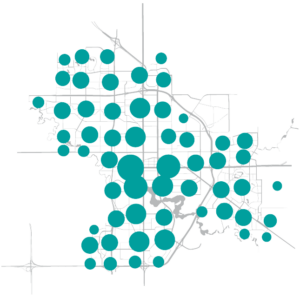According to the Canadian Urban Institute report, for every $1 invested in Canada’s urban libraries, $6 is generated in community economic impact – a return of over 600%.
In Regina, the Catalyst Committee predicted that for every dollar invested, a new Central Library will provide a benefit of $7.58.
Where is the economic impact?
- Regina Public Library (RPL) offers business programs, such as one-to-one career coaching, resumé help and career fairs – we help countless Regina people, many who have struggled with employment challenges, secure jobs every year.
- RPL offers personal finance programs giving Regina people the financial skills they need to survive and thrive in our changing world.
- RPL offers significant services and support to our newcomers, giving them the opportunity to become important contributors to our local economy and community.
- We work with many community partners throughout Regina. This means that when we connect with a socioeconomic demographic in need we provide the necessary support and services.
- RPL offers technology that allows everyone to participate in today’s digital world, from professional-level online learning resources to basic computer workstations and Wi-Fi. It’s hard to access jobs and other opportunities when you can’t afford a computer.
- Cultural and media services, such as the RPL Film Theatre, the Dunlop Art Gallery and the Digital Media Studio give Regina residents free access to high-quality technology, arts and entertainment.
- Library materials enrich people’s lives with access to countless physical and digital items at no cost – key for those who struggle.
- Programs offer customers opportunities for lifelong learning and the foundations of literacy.
- Public talks, forums and community gatherings offer dialogue and discourse on important conversations – vital for the health of our city.
Community Impact
RPL’s impact on the community’s wellbeing cannot be understated – everything we offer, every decision we make, is made with the community in mind, and how our services can benefit Regina’s public.
The library is not a nostalgic building full of books; it’s an integral part of building and supporting a healthy and vibrant community.
Did you know a busy downtown library is vitally important for a healthy downtown?
Roughly one-quarter of Regina Public Library’s 1.5 million annual visits occur at Regina’s downtown Central Library.
These visits are an essential part of Regina’s downtown, making downtown a safer, more vibrant, and more attractive area for other businesses, and for Regina residents and tourists.
The Canadian Urban Institute’s Report, The Case for Canada’s Public Libraries reminds us that “libraries are catalysts for neighbourhood and downtown revitalization…they’ve anchored plans to create strong downtown.”
One of the biggest spin-offs is that downtown libraries serve as a catalyst for economic development: people who visit libraries also visit nearby shops, restaurants, and businesses.
How do we know that?
We can look at what’s happened in other cities when they build a new central library:
- Calgary built a new library, doubled the number of visits to its downtown location and it has sustained that foot traffic ever since. Revitalization continues around this new library and the increased number of library visitors are key for this healthy downtown neighbourhood.
- The former Halifax Central Library welcomed the same number of annual visits that Regina’s Central Library currently sees at around 400,000. When Halifax opened a new library in 2014, the number of visits soared to two million per year. It also prompted development and revitalization of nearby businesses and housing.
We are confident a renewed Central Library will bring more foot traffic downtown:
- Central Library currently averages 400,000 visitors per year.
- We expect to add an additional 250,000-500,000 annual visits with a modern building. If we have the same experience as Halifax, we will see even more annual visitors.
More people downtown also encourages more people to live downtown and, just like in Halifax, we expect a renewed downtown library will spur new residential development.
Research Junction, a University of Saskatchewan and City of Saskatoon joint initiative, looked at ways to make downtown Saskatoon a more desirable place to live. They cited feedback from downtown residents indicating that public library facilities are important to increase the number of residents in a downtown location.
We anticipate that a renewed Central Library will contribute to a healthy downtown Regina where more people will want to live, work, and visit.
In early 2025, we spoke with some of our community leaders about a renewed Central Library. Here’s what they had to say.
We’ve had a lot of suggestions about building a new Central Library in The Bay space at Cornwall Centre.
That is a possibility, but only after we follow due process.
We are working on a Request for Proposals (RFP) process for developers to formally submit their ideas about a renewed Central Library.
The process will outline the project’s needs and asks for proposed solutions from qualified vendors.
Once an RFP is issued via SaskTenders, anyone with the appropriate credentials is welcome to apply, including the Cornwall Centre or any partners they might have.
All the proposals we receive will be assessed against a set of criteria that incorporates our goals and requirements for a new space.
It’s a long process: we don’t expect to select the best option until late 2025.
Central Library comes up a lot in conversation these days.
The support I hear from users and non-users, and the value people place on a new Central, is exciting.
I know it’s a tough time to ask for money. There are many needs, priorities and ways to spend, and I agree it’s important to be cautious and make wise decisions.
Libraries are valuable spaces in tough times. We don’t charge entry fees, and you don’t have to buy anything to stay for a while. There’s lots to do, lots to learn, and lots to discover.
With more than 400,000 visits in the past 12 months, Central Library is our busiest location, and use is increasing. It is a community hub that welcomes people from across the city and from every ward.
Let me tell you what’s going on at Central…
Your demand for library meeting rooms has increased as non-profits, boards, and community organizations look for affordable places to host meetings and events.
More kids and parents have been using the children’s play area, particularly after we introduced a MakerSpace – a place where kids work together on fun projects.
The number of school visits and tours for new users has increased.
Central has the highest amount of computer usage and the largest use of available hours across the system.
The Self-Serve Sound Studio – used to record music, podcasts, and other audio-visual projects – is booked at almost 100 per cent capacity most days.
Central is an activities branch. People still browse and borrow books, but it’s more of a destination to participate in programs, attend events, share stories, watch films, and visit the art gallery.
Modern central libraries are places for creativity, learning, sharing ideas, and cultural exchange. But the current Central was built in 1962 when a library’s primary function was to house books.
It wasn’t created for what’s needed now. And with all this new activity and new people, we have run out of room.
So, we must build something that suits the people of Regina. We’ll use our knowledge of modern library facilities to build an efficient, accessible, and affordable downtown library – one with space to provide the services our community wants… and with a few modest surprises thrown in for good measure.
The commitment of debt funding from City Council, coupled with the library’s mill rate, will allow us to do that. We won’t need debt funding until 2026 at the earliest, and not as one lump sum.
We are looking at other sources of funding including other levels of government, community grants, and fundraising. Any money we get will offset the amount needed through the City.
City Council’s approval of funding last summer has allowed RPL to move forward with procurement. We have requested input from developers and will soon invite proposals for the project. It’s a long process: we don’t expect to find the best option until late 2025.
Right now, we must move forward. If we delay, construction costs and costs to maintain the current building will increase.
Meanwhile…
There are thousands of newcomers who’ve never had a free library card and can’t wait to attend Central programs and use library services.
There are Indigenous youth who want to rediscover their culture and meet weekly at Central to sing and drum and learn the traditions of their ancestors.
There is a promising young artist who is recording her first album.
There are people who thank us for helping them find a job, get a degree, learn a new language, and more.
Great library design doesn’t have to be expensive. But it’s not going to get any cheaper.
Regina Public Library will continue to be fiscally responsible.
We can’t wait to work with the community to build a space that’s right for you.
You deserve a modern Central Library.
Think about that as you head to the polls.
You might notice some new ads about the Central Library project around Regina lately. We wanted to let you know just how important a new Central Library is for Regina!
There are more people than ever visiting Central Library – so much that it’s challenging to provide all of the services people want in our current building. Renewing Central Library is a necessary next step to meet this increased demand.
Explore the information below to learn more about the data behind the ads.
People from every neighbourhood in Regina visit Central Library.
RPL tracks the location of its customers based on postal codes. The circles on the map represent the volume of people in each area of the city who use their library card at Central. Library cards are used to borrow books and other materials, attend registered programs, use the Digital Media Studio, and more.
For every person who uses their library card at Central, there are about 10 more who discover, learn, and connect in other ways. We know this from our gate counts. Library cards are not required to attend drop-in programs or large events, explore the art gallery, watch a film, or simply enjoy the space.
Central Library has had more than 400,000 visits in the past 12 months. With a new building we expect this number to at least double.
For every dollar invested in a new Central Library, the benefits return will be $7.58. That’s value add for our community.

In the fall of 2022, the City’s Catalyst Committee explored five infrastructure projects – including Central Library – being proposed to City Council at relatively the same time. The Committee completed research to determine the strengths of each project, and in early 2023 released a report that made recommendations and a prioritized order for City Council to consider.
In their investigations and research, the Catalyst Committee determined that Regina residents will see a benefits return of $7.58 for every dollar invested in a new Central Library. In fact, the Committee estimated that the net benefits over 50 years would be $727 million.
- Read the Catalyst Committee report. Information on the methodologies begins in Section 5.2; p. 143 on the PDF and p. 124 in the document itself.
- Discover other Catalyst Committee documents, including the above report.
The committee also pointed out benefits that cannot be measured, such as a positive effect on child, adult literacy and computer literacy in our community. A new Central Library will provide opportunities to improve resident’s health, recreation, and connection to the community.
Our community deserves a modern Central Library to meet the community’s needs. Support Central Library, and you’re supporting a better future for Regina.
You might have seen some of our library statistics showing up across Regina over the summer. The campaign included information about the number of people who benefit from library services and some of the larger economic impacts of libraries. Libraries contribute so many amazing things to the community, and we wanted to share some of those facts with you.
Learn more about where these statistics come from below.
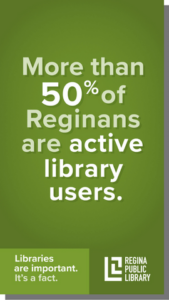
More than 50% of Reginans are active library users.
We define active library users as people who have used the library – either in person or online – within the last three years.
In fact, we believe this number is even larger because there are lots of cards used by more than one person in a family.
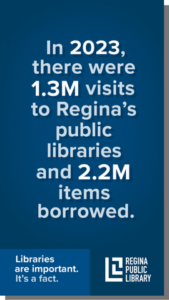
In 2023, there were 1.3M visits to Regina’s public libraries and 2.2M items borrowed.
In addition, there were:
- 14,370 new library cards issued;
- 1.6 million books and materials borrowed;
- 560,000 eBooks, eAudiobooks, and streaming movies, TV and music borrowed; and
- 5,396 library programs with 111,593 participants.
Looking for more information about how we report back to the community? Visit our annual reporting page and read our latest Annual Report.
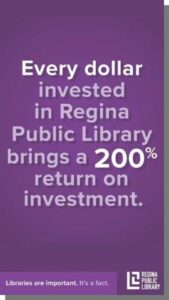
Every dollar invested in Regina Public Library brings a 200% return on investment.
According to third-party calculations, if you add up all the services we provide to the city, the economic benefit is estimated to be $70 million. As a result, RPL generates $2.98 in economic value for each dollar invested in it – the equivalent of $309 of value for each Regina resident.
This return on investment is similar to other Canadian library systems. It demonstrates that shared investment in library programs, activities, and services creates significant collective benefit for the dollars spent.
What’s more, the average value of one open hour at a library branch equates to $1,410.
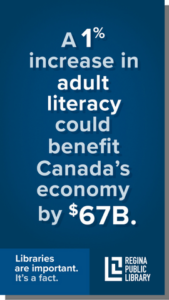
A 1% increase in adult literacy could benefit Canada’s economy by $67B.
That’s the equivalent of approximately $1,800 more in the pockets of each Canadian every year. You can learn more about the value of libraries in Canada from Overdue: The Case for Canada’s Public Libraries authored by the Canadian Urban Institute.
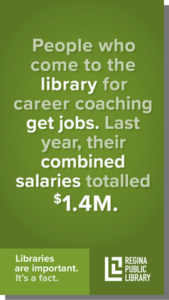
People who come to the library for career coaching get jobs. Last year, their combined salaries totalled $1.4M.
In 2023, RPL leveraged the expertise of 11 highly skilled volunteers to offer one-on-one career coaching sessions. Of the 27 individuals who secured jobs after participating, 26 got full-time professional positions with an estimated average annual salary of $54,511.71 per person. The combined amount of all 26 salaries was $1,432,304.53.
RPL’s career coaching program has created substantial positive impacts on job seekers, empowering individuals to decrease their reliance on social support and improve their overall quality of life. Additionally, RPL organized a highly impactful non-profit career fair with the participation of 25 non-profit organizations and an attendance of over 250 people.
Explore career coaching, and other business supports.
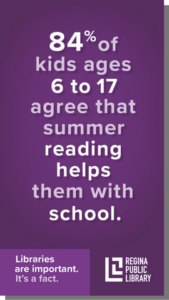
84% of kids ages 6 to 17 agree that summer reading helps them with school.
This was a key finding in the Kids and Family Reading Report Canadian Edition that the Scholastic company undertook in 2017 to explore the attitudes and behaviours of Canadian children and families around reading books for fun. Other key findings:
- Children, particularly those who are frequent readers, gain inspiration (76%) and a sense of accomplishment (90%) from reading.
- Parents’ reading habits play a large role in determining how often kids read: 57% of kids who are frequent readers have parents who read books 5–7 days per week, compared to only 15% of kids who are infrequent readers.
- Ninety-four percent of children agree that their favourite books are the ones they picked out themselves, and almost all children (92%) agree that they are more likely to finish a book they picked out.
- Ninety-seven percent of parents agree that every school should have a library.
A central library is more than just a structure. It is a common gathering place that unites communities and cultures. It represents a city’s character, its aspirations, and its commitment to the future. It is a source of pride for the community.
The vision for the new Central Library is to create a dynamic space that reflects the evolving needs of Regina’s diverse population. It’s about crafting a future where knowledge and opportunity are accessible to all, acting as a catalyst for downtown revitalization, and being a hub where everyone can come together.
Modern central libraries around the world have become spaces to support community priorities, economic growth, and improve quality of life.
- They act as a stimulus for growth in a city centre core, and a significant contributor to downtown revitalization.
- They attract visitors and serve as a catalyst for economic development in downtown areas. People who visit the library also visit shops, restaurants, and businesses downtown.
- They are safe and welcoming by design.
- They are community hubs that provide a welcoming and inclusive space where people can discover, learn, and connect, making them a vital part of the downtown community.
- They are beautiful places that make people proud. People visit just to be there. We want that for Regina too.
Key driving factors for a new central library in Regina include changing demographics, evolving service expectations, the condition and cost of maintaining the current aging facility, and community priorities and needs.
The new central library will enhance RPL’s programs and services, improve quality of life for Regina residents, and support economic growth in the region. Building a new central library would generate an estimated one-time economic impact of $93.8 million during construction, plus an additional $12.1 million from annual operations.

